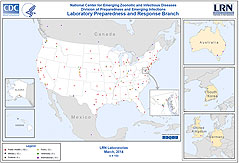National and International Coverage of the Laboratory Response Network (LRN)
LRN-member laboratories are strategically located across the United States and abroad, each playing a role in their state’s or territory’s overall emergency response plan. They include state and local public health, federal, military and international labs, each capable of performing confirmatory testing for high priority biological agents.
The majority of states and territories currently have laboratories that are designated as Biosafety Level 3 (BSL-3) facilities, meaning they are facilities that meet strict safety and security guidelines and personnel follow procedures that protect them and their colleagues from inadvertent infection. One of the LRN’s goals is to have all of its reference and national laboratories designated as BSL-3, which is the second highest laboratory safety designation available.
To promote faster detection of a disease outbreak, LRN facilities are located near densely populated areas. In fact, 87% of the U.S. population is located within a 100-mile radius of an LRN laboratory. This means LRN laboratories are able to respond faster to a local disease outbreak. Laboratories are capable of transferring samples to the nearest appropriate partner laboratory if they cannot perform the required tests or become overwhelmed.
- Page last reviewed: April 3, 2014
- Page last updated: September 30, 2014
- Content source:
- Maintained By:





 ShareCompartir
ShareCompartir
